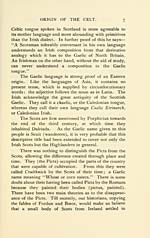Download files
Complete book:
Individual page:
Thumbnail gallery: Grid view | List view

6 THE ROMANCE OF THE HIGHLANDS.
The Romans, our first historians, tell us that they
found a fierce warlike people in Scotland, calling them-
selves Caledonians, Now, this name is composed of
two Celtic words, Cael, signifying Celts or Gauls, and
Dun, a hill, so that the Caledonians were the Gauls,
Gaels or Celts of the hilly country. The Highlanders
still call themselves Cael or Gael, their language Gaelic
or Gaelic, and their country Caeldock. The old eastern
word, Gaul, is, therefore, embodied in the name of
Caledonia, and remains to distinguish the Highlanders,
or Gaels, to the present day.
The Highlanders differ materially from the
inhabitants of the low country. They have never had
their language altered by successive waves of invasion
as has had the south, therefore it remains pure. Their
manners and customs prove them to be an ancient race.
They themselves say that they are the original natives of
the country, and they look upon all others as mixed
peoples. They do not acknowledge the appellation of
Scots, but call themselves Albanich, the inhabitants of
Albion. This was the name by which the country was
first known, and they have retained it through the ages.
It is still to be found in place names such as Drumalbain
and Breadalbane.
At the period of the Roman occupation the
Caledonians were divided into Picts, Scots, Angles, etc.
The Scots occupied Dalriada, or Argyle, and were also
found in Ireland. From this circumstance many have
conjectured that the Scots came from Ireland. This is
most unlikely. There is no proof that Ireland was a
settled country earlier than Britain. It might be that a
colony of Scots first crossed there, and, later, returned to
the main body. The Irish and Scots Celts differ very
considerably.
Macpherson has pointed out that the dialect of the
The Romans, our first historians, tell us that they
found a fierce warlike people in Scotland, calling them-
selves Caledonians, Now, this name is composed of
two Celtic words, Cael, signifying Celts or Gauls, and
Dun, a hill, so that the Caledonians were the Gauls,
Gaels or Celts of the hilly country. The Highlanders
still call themselves Cael or Gael, their language Gaelic
or Gaelic, and their country Caeldock. The old eastern
word, Gaul, is, therefore, embodied in the name of
Caledonia, and remains to distinguish the Highlanders,
or Gaels, to the present day.
The Highlanders differ materially from the
inhabitants of the low country. They have never had
their language altered by successive waves of invasion
as has had the south, therefore it remains pure. Their
manners and customs prove them to be an ancient race.
They themselves say that they are the original natives of
the country, and they look upon all others as mixed
peoples. They do not acknowledge the appellation of
Scots, but call themselves Albanich, the inhabitants of
Albion. This was the name by which the country was
first known, and they have retained it through the ages.
It is still to be found in place names such as Drumalbain
and Breadalbane.
At the period of the Roman occupation the
Caledonians were divided into Picts, Scots, Angles, etc.
The Scots occupied Dalriada, or Argyle, and were also
found in Ireland. From this circumstance many have
conjectured that the Scots came from Ireland. This is
most unlikely. There is no proof that Ireland was a
settled country earlier than Britain. It might be that a
colony of Scots first crossed there, and, later, returned to
the main body. The Irish and Scots Celts differ very
considerably.
Macpherson has pointed out that the dialect of the
Set display mode to: Large image | Transcription
Images and transcriptions on this page, including medium image downloads, may be used under the Creative Commons Attribution 4.0 International Licence unless otherwise stated. ![]()
| Early Gaelic Book Collections > Ossian Collection > Romance of the Highlands > (32) |
|---|
| Permanent URL | https://digital.nls.uk/81816009 |
|---|
| Description | Selected books from the Ossian Collection of 327 volumes, originally assembled by J. Norman Methven of Perth. Different editions and translations of James MacPherson's epic poem 'Ossian', some with a map of the 'Kingdom of Connor'. Also secondary material relating to Ossianic poetry and the Ossian controversy. |
|---|
| Description | Selected items from five 'Special and Named Printed Collections'. Includes books in Gaelic and other Celtic languages, works about the Gaels, their languages, literature, culture and history. |
|---|

